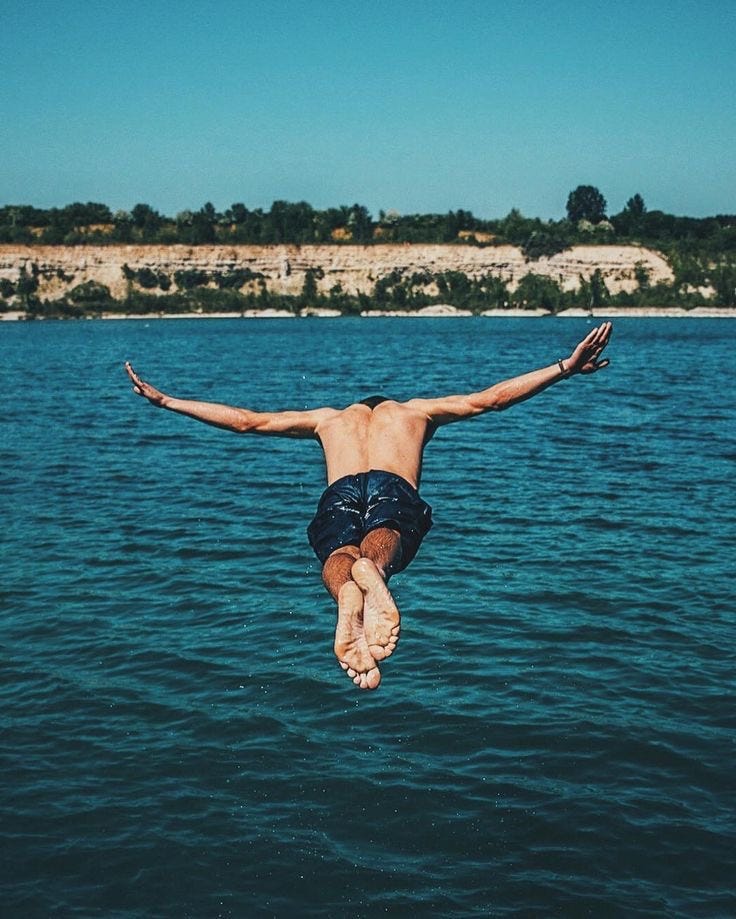Welcome to Present Sense – a weekend curation for Paid Subscribers – with 7 sensory recommendations: something to SEE, HEAR, SMELL, TASTE, TOUCH, BALANCE and ENVISION. Each edition also includes an audio guided meditation.
There was an immediate sense of recognition when I came across that quote by Fritz Perls, the psychiatrist who founded Gestalt therapy: “Fear is excitement without the breath.”
I’ve noticed how much these two emotions –– excitement and fear – work in tandem. Whenever excitement appears, fear always follows behind, like an inseparable shadow.
The dynamic doesn’t seem to work both ways. Not all fears come with excitement. There are many instances –– in the face of real danger – when fear isn’t accompanied by any positive feeling. Certain things are grim without shine.
However, I’ve rarely experienced excitement without a tinge of fear. Anytime something new and positive happens, my heart skips a beat of excitement and then starts pumping fear. In fact, the fear seems to be directly proportionate to the feeling of elation.
This interesting duo of emotions makes its entrance in the early stages of life. As children, we use fear as a vehicle for fun. We play peekaboo and like being chased, both screaming and laughing at the same time. We ride roller coasters, and watch scary movies.
And though I no longer engage in most of those activities, I still experience excitement and fear in tandem. It’s a specific fear, which isn’t rooted in any imminent danger but springs from an imagined catastrophic future. It’s the special fear flavor we call anxiety.
Whenever an exciting opportunity comes about, anxiety loves to create doom scenarios, prevention plans, and risk-averse calculations. It’s like a helicopter-parent, whose intentions may be loving, but whose actions tend to feel overbearing. In its attempt to minimize risk, it can also often dampen joy in the process.
The body registers excitement and fear in very similar ways. Indeed, they’re both stress responses. Excitement is considered a “good form” of stress, often referred to as “eustress.” While fear is a negative stress, with harmful physical and mental health effects.
It can be challenging to discern the difference. Whether I’m fearful or excited, my heart rate goes up, my hands get clammy, my pupils dilate. Excitement releases adrenaline and when anxiety joins, it floods us with cortisol –– creating a unique blended cocktail. The flavors aren’t always balanced though, and the mix can be hard to swallow.
So what can we do when our feeling pendulum swings from excitement to anxiety?
According to Perls, the answer is to breathe. It seems so basic, but the most profound advice is often very simple. Our mind has a tendency to overcomplicate things.
So I’ve put the theory to the test. I noticed that whenever something exciting occurs in my life, I first feel a sense of expansion in my body. But the feeling doesn’t seem to last long, as it’s quickly overtaken by an immediate feeling of contraction: fear.
What happens in that moment is that I’ve temporarily stopped breathing. It’s such a quick and automatic response that it’s hard to even perceive. But we often hold our breath, or limit it by making it shallow. I’m not sure the reason for this unconscious reaction, but I suspect that it gives us a sense of false control. Ironically, it has the inverse effect. On a basic level, we’re withholding oxygen from our body, which threatens our vital functions. The body naturally reacts by sending signals, creating a feeling of panic. It’s telling us: breathe, breathe, breathe. Take a deep inhale… and exhale.
This weekend's recommendations include a reading which dives deeper into this topic (and where I found the Fritz Perls’ quote). Some other sensory explorations: a recipe for a cold summer meal; a public library that loans more than books; and an audio guided meditation to help us move from anxiety to excitement.
In Joy,
Sabrina







